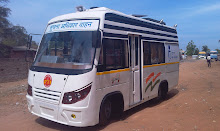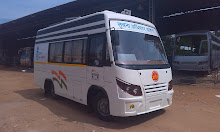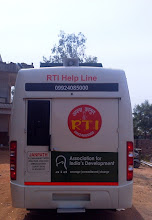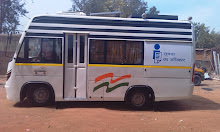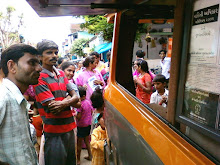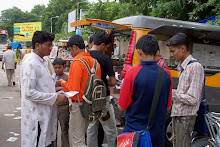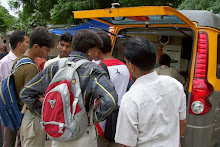Firstpost: New Delhi: Saturday,
April 08, 2017.
This is not a
story about Parshu. Why should it be? He’s just another needy two year old
running around playfully on his unwashed feet, smiling an unformed, unworldly
smile under a very drippy nose. Parshu, in a t-shirt with mucous stains and
patches of frozen black dust, is one among the nearly two lakh children living
on Delhi’s streets. Because poverty throws a thick blanket of resemblance over
people’s fortunes, it gets harder to tear through it and contest it in
instances. Parshu was born to teenaged parents two years ago, both balloon
sellers and drug addicts. The mother is now 20 and the father died of a
‘solution’ overdose some months ago.
There are
only five de-addiction centres in Delhi that are partly funded by the
government and managed by NGOs. Parshu is the only boy who lives in the sixth
and recently opened centre for women and child addicts in Parda Bagh, old
Delhi. Some centres have 15 beds, and others twice the number. Last year, these
establishments were complaining of a delay in funding from the government.
Their grudge was that the Delhi government (the nodal agency for inspection and
approvals of funds) delayed the release of their funds. Although that has been
resolved, the greater issue at hand here is that drug addiction still comes
under the purview of the Ministry of Social Justice and Empowerment, when it’s
actually a serious health problem that germinates in poverty and grows
cancerously in lonely, love-starved nerves. Doctors feel it should be addressed
immediately by the Ministry of Health and Family Welfare.
In the last
week of February, under the chairmanship of the chief secretary, government of
NCT of Delhi, a meeting of the Intersectoral Coordination Committee was
convened. The use of the word ‘intersectoral’ is the first formal proof of the
state’s understanding of the kind of response needed to address the problem.
According to
a recent survey conducted by the Delhi Aids Control Society, the number of
street children who used any substance in the last one year was 23,240 children
although the 95 per cent certainty estimate varied between 19,320 to 27,090
children based on statistical calculation. After excluding tobacco, the numbers
still are 15,470 street children. The study estimates that the number of
tobacco using street children was 20,000, a figure high enough to require
immediate intervention. The findings have revealed that alcohol is used by an
estimated 9,450 street children; inhalants are used by 7,910 street children;
cannabis is used by 5,600 street children; heroin was used by 840 street
children and pharmaceutical opioids and sedatives were used by 210 each; some
street children also reported injecting drug use. As per the 2016 survey
conducted by jointly by the Women and Child Development Department and AIIMS in
2016, there are 70,000 addicts on Delhi’s streets and their initiation into
drugs happens as early as age nine.
A total of 30
beds in six hospitals have been earmarked exclusively for juveniles but there
is lack of staff in these centres. A proposal has been initiated for creation
of posts in these five existing de-addiction centres. In the drug de-addiction
centres planned in government hospitals, there is a revised proposal for the
increase in staff for round the clock inpatient care from one to three in each
centre. Muskan Foundation runs a de-addiction centre in Amberhai, Dwarka. Dr
Bharat Bhushan, who runs the facility, says increasing staff is important
because the treatment cannot be limited to the three-week detoxification, it
has to be intensive and lengthy so there is a less chance of relapse. Right
now, a 60 to 90 percent relapse rate pulls the addict back into the black hole
of addiction. To consolidate the approach towards de-addiction, the Delhi State
Aids Control Society has made proposals like the establishment of additional
oral substation therapy centres, specialised counselling centres for targeted
interventions, capacity building and training support and intervention efforts
in women and children addicts. For these activities, it has been proposed that
a budget of Rs 10 crore per annum be kept aside.
Last year,
AIIMS introduced a specialised course to generate five specialists of drug
abuse each year. AIIMS runs two community clinics in Delhi, in Trilokpuri and
Sunder Nagri, which engage with low-threshold patients. The reason for this, as
Dr Atul Ambekar of AIIMS National Drugs Dependence Treatment Centre in
Ghaziabad explains, was that addiction was seen as part of general psychiatry,
when it is actually a far more specific problem.
In response
to an RTI filed to Delhi’s government hospitals in May 2016 for information on
drug de-addiction services offered, it was stated that specialised drug
de-addiction services declined at Safdarjung Hospital and VMMC; Lady Hardinge
Medical College and SSK Hospital had just one child addict admitted in IPD in
2014-2015 and none in 2015-2016. No female addicts were registered in both
years. If one is to visit the centre for women and children at Parda Bagh,
little girls will tell you how it’s quite routine for them to get hold of a
bottle of solution (chemical drug) for Rs 60 and children in Meena Bazar,
Hanuman Mandir, Jhandewalan, are easy targets for peddlers. The girls (between
7 and 15) said they started out with shikhar chewing tobacco and then
‘bhaiyas’ started selling them solution. Replying to the same RTI, Dr Ram
Manohar Lohia Hospital stated that the total number of drug de-addiction
patients IPD was only six in 2014 and 22 in 2015. It has been finally been
proposed that the Health and Welfare Department will look into activating beds
for de-addiction treatment in these hospitals.
A 30-bed
facility has been proposed to come up at Tilak Vihar, where there is a minimum
of one addict in each home. Other regions in need of immediate relief are New
Seelampur and Seemapuri, where NGOs like Asha and Parivartan are doing their
bit to educate and reform. Last year, Haji Ishraq, MLA-New Seelampur, told
Firstpost that the MCD doesn’t provide the government land for building a
‘nasha mukti kendra’ and that explains why addicts pass out and fall like dead
bodies even outside police stations.
Aside from
the six government centres, there are also a large number of private drug
de-addiction centres across the capital. Some brand themselves as
neuro-psychiatric centres and others call themselves wellness retreats. For the
first time, the government has acknowledged that these facilities must be
monitored. A standardised procedure for drug-relief must be put in place. In
fact, government doctors reveal that the 150-odd private NGOs across Delhi
aren’t verified by any authority and the use of muscle and stronger substitute
medicines in order to prolong addiction also happens.
School
children are an impressionable lot and get lured into addiction in packs. There
are 1,240 schools with 13.5 lakh students from Class 6-12. A screening of these
children for traces of drug abuse has been suggested. The East and South Delhi
municipal corporations have trained their staff at IHBAS for this purpose,
along with this, even Mohalla Clinics situated near schools are to start
screening students regularly. Along with this, the government has finally
admitted the need for a survey that’ll help quantify the problem. Currently, no
consolidated survey of drug abuse in school children exists.
The Delhi
police, the Narcotics Bureau and the Drug Control Department are the main
agencies involved in regulation and supply of reduction of drugs of abuse. The
information collated from investigating agencies on drugs banned under the
Narcotic Drugs and Psychotropic Substances (NDPS) Act showed that Delhi had the
highest seizure of chemical based intoxicants such as mandrax, syrup and
tablets. The data tabled in the Lok Sabha earlier this month indicates that
anti-drug agencies caught 23,519 kg mandrax, 98,480 kg syrup and 1.77 lakh
tablets in Delhi in 2016. While the Drug Control Department has cancelled 18
drug licences of pharmacies to curb illegitimate drug abuse, residents in Tilak
Vihar, Seemapuri and Seelampur say it is still quite easy to get hold of Avil
(anti-inflammatory for aches and allergies), Siazepam (tranquilising muscle
relaxant), Nitrazepam (short-term relief from insomnia and anxiety), Alprax (a
sedative, hypnotic, anxiolytic) and Phenergan (antihistamine, sedative, and
anti-nausea drug) over the counter. “Badi dukaan par nahi toh choti dukaan par
zarur milega, nahi toh bhaiya leke aayenge,” says Bima, a child addict outside
Hanuman Mandir, Cannaught Place. (Later, Bima took Firstpost to the ‘bhaiya’ or
peddler, a teenage boy, offering a red and white tube for Rs 100 outside Hanuman
Mandir. Fearing he’ll be caught, he ran away and merged into the crowds near
the temple gates.)
It is not
merely a question of breaking the chain of supply and demand of drugs but of
rescuing those 70,000 childhoods that are being lost to this cheap poison each
and every day.











